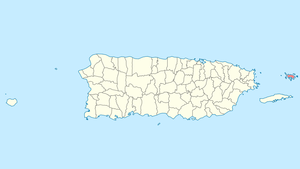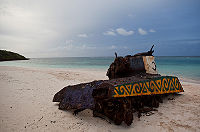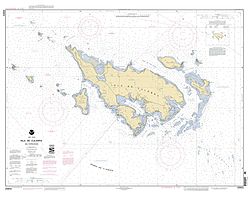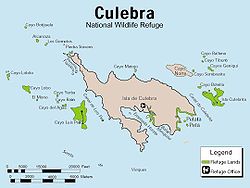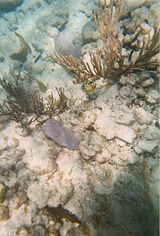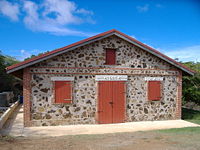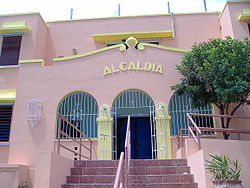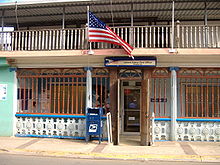- Culebra, Puerto Rico
-
Culebra, Puerto Rico — Municipality — 
Flag
Coat of armsNickname(s): La Isla Chiquita (Little Island), Última Virgen (Last Virgin) Anthem: "Culebra Isla preciosa" Location of Culebra in Puerto Rico Coordinates: 18°19′01″N 65°17′24″W / 18.31694°N 65.29°WCoordinates: 18°19′01″N 65°17′24″W / 18.31694°N 65.29°W Country United States Territory Puerto Rico Founded October 27, 1880 Government – Mayor TBD – Senatorial dist. 8 - Carolina – Representative dist. 36 Area – Total 11.6 sq mi (30.1 km2) – Land 10.8 sq mi (28 km2) Population (2010) – Total 1,818 – Density 156.4/sq mi (60.4/km2) – Racial groups
(2000 Census) [1]60.6% White
20.9% Black
1.0% American Indian/An
1.1% Asian
0.1% Native Hawaiian/Pi
13.0% Some other race
3.4% Two or more racesTime zone AST (UTC-4) Zip code Isla Culebra (Spanish pronunciation: [kuˈleβɾa], "Snake Island") is an island-municipality of Puerto Rico originally called Isla Pasaje and Isla de San Ildefonso. It is located approximately 17 miles (27 km) east of the Puerto Rican mainland, 12 miles (19 km) west of St. Thomas and 9 miles (14 km) north of Vieques. Culebra is spread over 5 wards and Culebra (Dewey) Pueblo (The downtown area and the administrative center of the city). The island is also known as Isla Chiquita ("Little Island") and Última Virgen ("Last Virgin", reflecting its position at the end of the Virgin islands archipelago). Residents of the island are known as Culebrenses.
Contents
History
Some sources claim that Christopher Columbus was the first European to arrive at the island during his second voyage in 1493.[2][3][4] It is believed that the island was populated by Carib Indians during the colonization, After the Agüeybaná and Agüeybaná II#Taíno rebellion of 1511, Taíno Indians from the main island sought refuge on Culebra and allied with Caribs to launch random attacks at the island estates.[5]
After that, the island was left abandoned for centuries. During the era of Spanish commerce through the Americas, it was used as a refuge for pirates, as well as local fishermen and sailors.[6] Some sources mention an Englishman named Stevens, who mas put in charge of Culebra in 1875 by the Spanish crown to protect the island from foreigners.[7]
Culebra was then settled by Cayetano Escudero Sanz on October 27, 1880. This first settlement was called San Ildefonso, to honor the Bishop of Toledo, San Ildefonso de la Culebra. Two years later, on September 25, 1882, construction of the Culebrita Lighthouse began. It was completed on February 25, 1886 which made it the oldest operating lighthouse in the Caribbean until 1975, when the U.S. Navy and Coast Guard finally closed the facility.[8]
In 1902, Culebra was integrated as a part of Vieques. One year later, on June 26, President Theodore Roosevelt established the Culebra Naval Reservation. A bird refuge was established on February 27, 1909.[9][10] In 1939, the U.S. Navy began to use the Culebra Archipelago as a gunnery and bombing practice site. This was done in preparation for the United States' involvement in World War II. In 1971 the people of Culebra began protests, known as the Navy-Culebra protests, for the removal of the U.S. Navy from Culebra. Four years later, in 1975, the use of Culebra as a gunnery range ceased and all operations were moved to Vieques.
Culebra was declared an independent island municipality in 1917. The first democratically elected government was put into place in 1960. Prior to this, the government of Puerto Rico appointed delegates to administer the island.
Geography
Culebra is an archipelago consisting of the main island and twenty-three smaller islands that lie off its coast. The largest of these cays are: Culebrita to the east, Cayo Norte to the northeast, and Cayo Luis Peña and Cayo Lobo to the west. The smaller islands include Cayo Ballena, Cayos Geniqui, Arrecife Culebrita, Las Hermanas, El Mono, Cayo Lobito, Cayo Botijuela, Alcarraza, Los Gemelos, and Piedra Steven. Islands in the archipelago are arid, meaning they have no rivers or streams. All of the fresh water is brought from Puerto Rico via Vieques.
Culebra is characterized by an irregular topography resulting in a long intricate shoreline. The island is approximately 7 by 5 miles (11 by 8 km). The coast is marked by cliffs, sandy coral beaches and mangrove forests. Inland, the tallest point on the island is Mount Resaca, with an elevation of 650 feet (198 m), followed by Balcón Hill, with an elevation of 541 feet (164.9 m).
Ensenada Honda is the largest harbor on the island and is considered to be the most hurricane secure harbor in the Caribbean.[citation needed] There are also several lagoons on the island, like Corcho, Flamenco, and Zoní. Culebrita Island also has a lagoon called Molino.
Almost 80% of the island's area is volcanic rock from the Cretaceous period. It is mostly used for livestock pasture, as well as some minor agriculture.[11]
Nature Reserves
These small islands are all classified as nature reserves and several nature reserves also exist on the main island. One of the oldest bird sanctuaries in United States territory was established in Culebra on February 27, 1909 by President Teddy Roosevelt.[12] The Culebra Island Giant Anole (Anolis roosevelti, Xiphosurus roosevelti (according to ITIS)) is an extremely rare or possibly extinct lizard of the Anolis genus. It is native to Culebra Island and was named in honor of Theodore Roosevelt, Jr., who was the governor of Puerto Rico at that time. There are bird sanctuaries on many of the islands as well as turtle nesting sites on Culebra. Leatherback, green sea and hawksbill sea turtles use the beaches for nesting. The archipelagos bird sanctuaries are home to brown boobies, laughing gulls, sooty terns, bridled terns and noddy terns. An estimated 50,000 sea birds find their way back to the sanctuaries every year. These nature reserves comprise 1,568 acres (6.35 km2) of the archipelago's 7,000 acres (28 km2). These nature reserves are protected by the United States Fish and Wildlife Service.
Culebra has no natural large mammals. However, a population of White-tailed deer introduced in 1966 can be found on the eastern region of the island.[12]
National protected area
Cityscape
Barrios
Barrio area
m²[13]population
(census
2000)density islands in barrio Culebra barrio-pueblo 408969 652 1594.3 - Flamenco 12602398 885 70.2 Cayo Pirata, Cayo Verde, Cayo Matojo, El Ancon, Piedra Stevens, Los Gemelos, Alcarraza, Roca Lavador (awash), Cayo Botijuela, Cayo de Luis Peña, Las Hermanas (Cayo del Agua, Cayo Ratón, Cayo Yerba), El Mono, Cayo Lobo, Roca Culumna (Part of Cayo Lobito), Cayo Lobito, Cayo Tuna Fraile 8211978 51 6.2 Culebrita, Cayo Botella, Pelá, Pelaita Playa Sardinas I 410235 136 331.5 - Playa Sardinas II 2600088 122 46.9 - San Isidro 5857771 22 3.8 Roca Speck, Cayo Norte, Cayo Sombrerito, Cayos Geniquí, Cayo Tiburón, Cayo Ballena Culebra 30091439 1.868 62,1 23 islands, cays and rocks Tourism
Culebra is a popular weekend tourist destination for Mainland Puerto Ricans, Americans and residents of Vieques. Because of the "arid" nature of the island there is no run-off from rivers or streams resulting in very clear waters around the archipelago.
Culebra has many beautiful beaches including Flamenco Beach (Playa Flamenco), which can be reached by shuttle buses from the ferry. The beach extends for a mile of white coral sand and is framed beautifully by arid tree-covered hills. The beach is also protected by the Department of Natural and Environmental Resources as a Marine Wildlife Reserve.
The area west of Flamenco Beach and the adjacent Flamenco Point were used for joint-United States Navy/Marine Corps military exercises until 1975. Many military relics, including tanks, remain in the area. Culebra and Vieques offered the U.S. military an experience of great value to the battles in the Pacific as a feasible training area for the Fleet Marine Force in amphibious exercises for beach landings and naval gunfire support testing. Culebra and Vieques were the two components of the Atlantic Fleet Weapons Range Inner Range. In recent years, only the shortened term "Inner Range" was used.
Other beaches are only accessible by private car or boats. Of the smaller islands, only Culebrita and Luis Peña permit visitors and can be accessible via water taxis from Culebra. Hiking and nature photography are encouraged on the small islands. However, activities which would disturb the nature reserves are prohibited, e.g. Camping, Littering and Motor Vehicles. Camping, however, is allowed on Playa Flamenco throughout the year. Reservations are recommended. Culebra is also a popular destination for scuba divers because of the many reefs throughout the archipelago and the crystal clear waters.
Landmarks and places of interest
- Flamenco Beach Ranked # 2 in the top 10 most exotic beaches in the world.[14]
- Brava Beach
- Las Vacas Beach
- Larga Beach
- Pueblo Español
- Punta Soldado Beach
- Resaca Beach
- Tamarindo Beach
- Tortuga Beach
Culture
- Windsurfing Competition - February
- Fishing Tournament - March
- Patron Festivities - June
- Craft Festivities - November
Economy
In past centuries, agriculture was the main source of economy in Culebra. At some point, the following products were produced and exported from the island: wood, turtle oil, shells, fish, tobacco, livestock, pigs, goats, cheese, plantains, pumpkins, beans, yams, garlic, corn, tomatoes, oranges, coconut, cotton, melons, mangrove bark, coal, and turkey.[15]
Nowadays, Culebra's main source of revenue comes from construction, tourism, and a pharmaceutical plant located in the Dewey community.[16]
Demographics
According to the 2010 Census, the population of Culebra is 1,818. This makes the island the municipality with the smallest population in Puerto Rico.[17]
In 1894, written reports indicated that there were 519 residents living in five communities: San Ildefonso, Flamenco, San Isidero, Playa Sardinas I y II, and Frayle. There were 84 houses built, 24 of them in the San Ildefonso community.[18]
Government
Like all of Puerto Rico's municipalities, the island of Culebra is administered by a mayor, elected every four years in general elections. Iniitally, administrators were selected by the Spanish crown or by the United States government during the 19th and early 20th Century.
In 2004, Abraham Peña Nieves was elected mayor of Culebra with 50.1% of the votes.[19] He was reelected in 2008.[20]
On November 2011, Peña died of prostate cancer.[21] The next day, it was announced that his daughter, Lizaida Peña, might replace him until the 2012 general elections.[22]
Government services
The United States Postal Service operates the Culebra Post Office.[23]
Symbols
Flag
The Culebra flag consists of five vertical stripes, three alternate yellow and two green ones. The yellow central stripe has the map of Culebra in green.
Coat of Arms
This crown consists of sterns of two ships with their sails filled by the wind. The cross and the episcopal walking stick symbolize Bishop San Ildefonso, because originally the island was called San Ildefonso de la Culebra. The serpent (culebra means serpent) symbolizes its name. An armed arm from the Coat of Arms of the Escudero family, first settlers of the island. The laurel cross refers to the civic triumph reached when Culebra obtained the evacuation of the United States Navy from the island.
Education
Due to its size and small population, there are only three schools on Culebra, one for each level. They are the San Ildefonso Elementary School, the Antonio R. Barceló High School, and the Luis Muñoz Rivera school. Education is administered by the Puerto Rico Department of Education.
Health care
There is a small hospital in the island called Hospital de Culebra. It also offers pharmacy services to residents and visitors. For emergencies, patients are transported by plane to Fajardo on the main island.[24]
Transportation
The island of Culebra can be reached through private boats, ferry, or plane. Ferry service is available from Fajardo. Ferries make several trips a day to the main island for an approximate fare of $4.50 (round trip).[25][26]
Culebra also has a small airport, Benjamín Rivera Noriega Airport, with domestic service to the mainland and Vieques. The airport is served by small airlines:
- Air Culebra from San Juan's Luis Muñoz Marín and Isla Grande Airports.
- Air Flamenco provides service from Fernando Luis Ribas Dominicci Airport in Isla Grande, Luis Muñoz Marín International Airport in San Juan, and José Aponte de la Torre Airport in Ceiba.
- Vieques Air Link provides service to Culebra from San Juan and Fajardo.
- M&N Aviation from Fernando Luis Ribas Dominicci Airport in Isla Grande, and José Aponte de la Torre Airport in Ceiba.
There is public transportation available in the island, through public cars and taxis.
Gallery
See also
References
- ^ Demographics/Ethnic U.S 2000 census
- ^ Culebra, Puerto Rico on AreciboWeb
- ^ Costa Bonita Villas: Historia on CostaBonitaPR.com
- ^ Isla de Culebra on PRFrogui
- ^ Historia de Culebra on PorMiPueblo
- ^ Historia de Culebra on PorMiPueblo
- ^ Historia - Culebra on IslaCulebra.com
- ^ Culebra, Isla Chiquita on SalonHogar.net
- ^ Historia de Culebra on PorMiPueblo
- ^ Isla de Culebra on PRFrogui
- ^ Isla de Culebra on PRFrogui.com
- ^ a b Flora and Fauna of Culebra, Puerto Rico
- ^ "Detailed Tables - American FactFinder". Factfinder.census.gov. http://factfinder.census.gov/servlet/DTTable?_bm=y&-state=dt&-ds_name=DEC_2000_SF1_U&-mt_name=DEC_2000_SF1_U_P001&-redoLog=false&-transpose=N&-geo_id=06000US7204922632&-geo_id=06000US7204928566&-geo_id=06000US7204929426&-geo_id=06000US7204963396&-geo_id=06000US7204963439&-geo_id=06000US7204976382&-geo_id=NBSP&-format=&-_showChild=Y&-_lang=en&-show_geoid=Y. Retrieved 2010-06-10.
- ^ Beach Bum Paradise: The Top Ten Most Exotic Beaches in the World Part 1
- ^ Historia - Culebra on IslaCulebra
- ^ Culebra, Puerto Rico - Gobierno/Economía on IslaCulebra
- ^ Población de Puerto Rico on ElectionsPuertoRico.org
- ^ Historia - Culebra on IslaCulebra
- ^ Culebra on SalonHogar.com
- ^ Comisión Estatal de Elecciones de Puerto Rico: Escrutinio General de 2008 on CEEPUR.org
- ^ Muere el alcalde de Culebra on El Nuevo Día (November 17, 2011)
- ^ Hija del alcalde de Culebra esta dispuesta a sustituirlo on El Nuevo Día; Caquías, Sandra (November 18, 2011)
- ^ "Post Office Location - CULEBRA." United States Postal Service. Retrieved on May 18, 2010.
- ^ Culebra Overview on Let's Go
- ^ Culebra Ferry Schedule on IslaCulebra
- ^ Culebra Ferry Schedule on Culebra-Island.com
External links
Categories:- Culebra, Puerto Rico
- Islands of Puerto Rico
- Populated places established in 1880
- Municipalities of Puerto Rico
Wikimedia Foundation. 2010.

